An art movement is a tendency or style in art with a specific common philosophy or goal, followed by a group of artists during a specific period of time, or, at least, with the heyday of the movement defined within a number of years. Art movements were especially important in modern art, when each consecutive movement was considered a new avant-garde movement. Western art had been, from the Renaissance up to the middle of the 19th century, underpinned by the logic of perspective and an attempt to reproduce an illusion of visible reality. By the end of the 19th century many artists felt a need to create a new style which would encompass the fundamental changes taking place in technology, science and philosophy.

Sir John Collings Squire was a British writer, most notable as editor of the London Mercury, a major literary magazine in the interwar period. He antagonised several eminent authors, but attracted a coterie that was dubbed the Squirearchy. He was also a poet and historian, who captained a famous literary cricket-team called the Invalids.
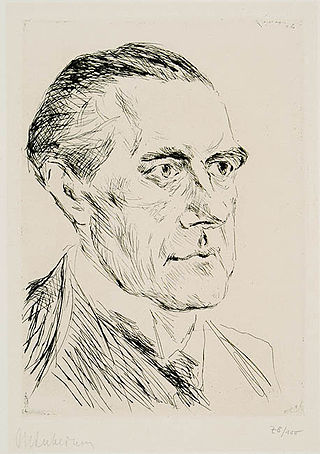
Peter Behrens was a leading German architect, graphic and industrial designer, best known for his early pioneering AEG Turbine Hall in Berlin in 1909. He had a long career, designing objects, typefaces, and important buildings in a range of styles from the 1900s to the 1930s. He was a foundation member of the German Werkbund in 1907, when he also began designing for AEG, pioneered corporate design, graphic design, producing typefaces, objects, and buildings for the company. In the next few years, he became a successful architect, a leader of the rationalist / classical German Reform Movement of the 1910s. After WW1 he turned to Brick Expressionism, designing the remarkable Hoechst Administration Building outside Frankfurt, and from the mid-1920s increasingly to New Objectivity. He was also an educator, heading the architecture school at Academy of Fine Arts Vienna from 1922 to 1936. As a well known architect he produced design across Germany, in other European countries, Russia and England. Several of the leading names of European modernism worked for him when they were starting out in the 1910s, including Ludwig Mies van der Rohe, Le Corbusier and Walter Gropius.

Dora Marsden was an English suffragette, editor of literary journals, and philosopher of language. Beginning her career as an activist in the Women's Social and Political Union, Marsden eventually broke off from the suffragist organization in order to found a journal that would provide a space for more radical voices in the movement. Her prime importance lies with her contributions to the suffrage movement, her criticism of the Pankhursts' WSPU, and her radical feminism, via The Freewoman. There are those who also claim she has relevance to the emergence of literary modernism, while others value her contribution to the understanding of Egoism.
This is a chronological bibliography of books and a general bibliography of articles by the author Hilaire Belloc. His books of verse went through many different editions, and are not comprehensively covered.

The Egoist was a London literary magazine published from 1914 to 1919, during which time it published important early modernist poetry and fiction. In its manifesto, it claimed to "recognise no taboos", and published a number of controversial works, such as parts of Ulysses. Today, it is considered "England's most important Modernist periodical."
The Little Review, was an American avant-garde literary magazine founded by Margaret Anderson in Chicago's historic Fine Arts Building, published literary and art work from 1914 to May 1929. With the help of Jane Heap and Ezra Pound, Anderson created a magazine that featured a wide variety of transatlantic modernists and cultivated many early examples of experimental writing and art. Many contributors were American, British, Irish, and French. In addition to publishing a variety of international literature, The Little Review printed early examples of surrealist artwork and Dadaism. The magazine's most well known work was the serialization of James Joyce's Ulysses.
Literary modernism, or modernist literature, originated in the late 19th and early 20th centuries, and is characterized by a self-conscious separation from traditional ways of writing in both poetry and prose fiction writing. Modernism experimented with literary form and expression, as exemplified by Ezra Pound's maxim to "Make it new." This literary movement was driven by a conscious desire to overturn traditional modes of representation and express the new sensibilities of the time. The horrors of the First World War saw the prevailing assumptions about society reassessed, and much modernist writing engages with the technological advances and societal changes of modernity moving into the 20th century. In Modernist Literature, Mary Ann Gillies notes that these literary themes share the "centrality of a conscious break with the past", one that "emerges as a complex response across continents and disciplines to a changing world".
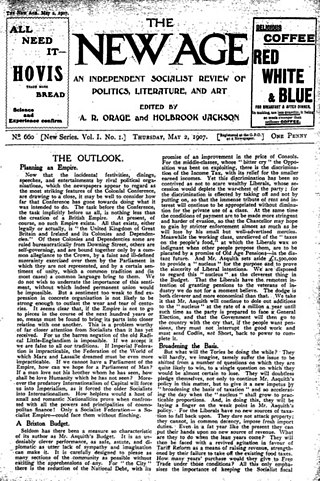
The New Age was a British weekly magazine (1894–1938), inspired by Fabian socialism, and credited as a major influence on literature and the arts during its heyday from 1907 to 1922, when it was edited by Alfred Richard Orage. It published work by many of the chief political commentators of the day, such as George Bernard Shaw, H. G. Wells, Hilaire Belloc, G. K. Chesterton and Arnold Bennett.
The New Freewoman was a monthly London literary magazine edited by Dora Marsden and owned by Harriet Shaw Weaver. Initially, Rebecca West was in charge of the literary content of the magazine, but after meeting Ezra Pound at one of Violet Hunt's parties in 1913 she recommended that he be appointed literary editor. The magazine existed between June 1913 and December 1913.

Alfred Francis Kreymborg was an American poet, novelist, playwright, literary editor and anthologist.
The Freewoman was an English feminist weekly review published between 23 November 1911 and 10 October 1912, and edited by founder Dora Marsden and Mary Gawthorpe.

William Stanley Beaumont Braithwaite was an African-American writer, poet, literary critic, anthologist, and publisher in the United States. His work as a critic and anthologist was widely praised and important in the development of East Coast poetry styles in the early 20th century. He was awarded the Spingarn Medal in 1918.

The governor of San Luis Potosí exercises the role of the executive branch of government in the Mexican state of San Luis Potosí, per the Political Constitution of the Free and Sovereign State of San Luis Potosí. The official title is Gobernador Constitucional del Estado Libre y Soberano de San Luis Potosí.
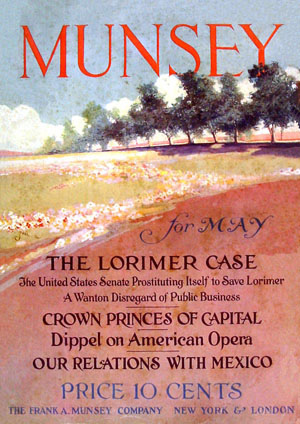
Munsey's Weekly, later known as Munsey's Magazine, was a 36-page quarto American magazine founded by Frank A. Munsey in 1889 and edited by John Kendrick Bangs. Frank Munsey aimed to publish "a magazine of the people and for the people, with pictures and art and good cheer and human interest throughout". Soon after its inception, the magazine was selling 40,000 copies a week. In 1891, Munsey's Weekly adopted a monthly schedule and was renamed Munsey's Magazine.

Rhythm was a literary, arts, and critical review magazine published in London, England, from 1911 to 1913.
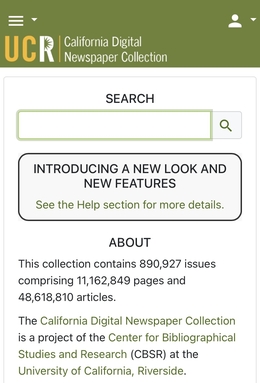
The California Digital Newspaper Collection (CDNC) is a freely-available, archive of digitized California newspapers; it is accessible through the project's website. The collection contains over six million pages from over forty-two million articles. The project is part of the Center for Bibliographical Studies and Research (CBSR) at the University of California Riverside.
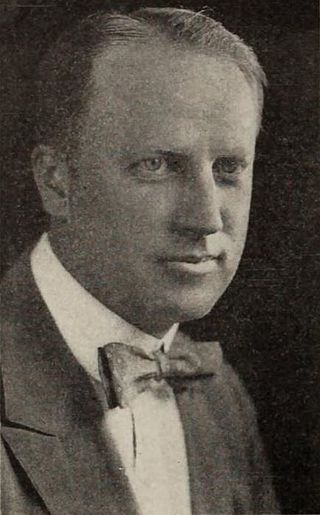
Rollin Summers Sturgeon was an American film director of silent films active from 1910 to 1924. He directed 101 films during this period.

This is a list of newspapers and magazines in the United States owned by, or editorially supportive of, the Socialist Party of America.